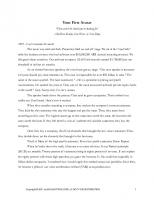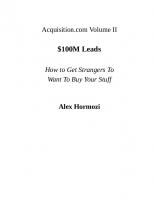$100M Offers - The Lost Chapter
1,955 549 976KB
English Pages 8 Year 2021
Recommend Papers

- Author / Uploaded
- Alex Hormozi
File loading please wait...
Citation preview
Your First Avatar “These aren’t the droids you’re looking for” - Obi-Wan Kenobi, Star Wars: A New Hope 2019 - I can't remember the month. The room was cold and dark. Presenters filed on and off stage. We sat at the “cool kids” table for business owners who had software over $10,000,000 ARR (annual recurring revenue). We felt good about ourselves. Our software company ALAN had recently crossed $1,700,000 per mo threshold in its first six months. As we chatted between speakers, the event host got on stage. “Our next speaker is someone everyone should pay close attention to. This man is responsible for over $50 billion in sales." The noise in the room quieted. The host continued, “...He is a specialist in pricing and profit maximization. He worked for years at Vista, one of the most renowned software private equity funds in the world.” Gulp. Reality check. I'm still a minnow. The speaker broke down the process Vista used to grow companies. Their method was unlike any I had heard. Here's how it worked. When they consider acquiring a company, they analyze the company's current customers. They look for the customers who stay the longest and pay the most. Then, they score them according to this value. The highest scores go to the customers worth the most, the lowest to the ones worth the least. If they feel there's a vein of underserved valuable customers, they buy the company. Once they buy a company, they'd cut channels that brought the low value customers. Then, they double down on the channels that brought in the best ones. That’s it. More of the high profit customers. Fewer low profit customers. Rinse. Repeat. When he broke down the math, it became even more obvious. It was Pareto's principle (80/20) on steroids. Twenty percent of customers bring in eighty percent of revenue. If you replace the eighty percent with those high spenders, you grow the business 5x. No small feat, especially in billion dollar companies. I wondered how I could apply this method across our portfolio. Since then, it's become a pillar of our value acceleration method (VAM) at acquisition.com
Copyright © 2021 by ACQUISITION.COM LLC NOT FOR DISTRIBUTION
1
Finding the Right Customers Earlier, I talked about picking the right market. It's an important strategic business decision. Choosing the perfect avatar is a subset of that larger decision. This is where we become more nuanced about exactly who we serve, and more importantly, who we do not. There are four steps to installing this process. I outline them below. Then, I share what we found after implementing this in Gym Launch. Here are the steps. 1) Survey your customers: Set up a form with the questions below and send it out. Or, for higher engagement, go over it with them live at an event or on a call. Make sure they show they completed it to receive some benefit. Ask them every relevant detail you’d want to know. Here’s an example of questions I would ask business services customers: a) Demographics: Who are they? Age? Gender? Political affiliation? Geographic location? Digital Location? Single/Divorced? Partnered in business or solopreneur? b) Business Stats Before & Current: Revenue? Profit,? # of employees? Churn? Pricing? Products? Customer lifetime value? # of customers? Niche? How long in business? c) Aspirations: What was their goal upon purchasing your services/products? What problem were they trying to solve? d) Buying Process: What's the single biggest reason they bought? Was there a trigger event that caused them to buy? Did they consume any specific piece of content? Was there a specific testimonial they consumed? How many pieces did they consume? When did they first hear about you vs when they bought? Where did they first see us? Did someone refer them? 2) Find your biggest spenders: Sort the replies by the customers you like the most, spent the most, and stayed the longest. Focus on the top 20%. Ignore the rest. 3) See what they have in common: This takes reading through all the answers and using your brain. I know. Thinking is hard. The good news is - your competitors won’t do it - easy advantage. Goal: Come up with the fewest qualifiers they all have in common. Now, list them out. Usually there are three to five qualifiers. 4) Execute: Once you have these answers you’re going to do two important things. a) Speak your new avatar. Be upfront about your customer requirements. Get all advertising to speak directly to them. You will repel the bad customers and attract the good ones. Stop selling anyone who does not meet your ideal customer
Copyright © 2021 by ACQUISITION.COM LLC NOT FOR DISTRIBUTION
2
requirements. Seriously, stop it. Then, increase effort on the channels these people come through b) Re-engineer The Sales Process. Look at what caused these better customers to buy. Reverse-engineer the buying process your best customers went through. Then, make it happen on purpose.
Copyright © 2021 by ACQUISITION.COM LLC NOT FOR DISTRIBUTION
3
Here’s what happened after we did it. We did steps one through three. We surveyed. We sorted for the biggest spenders. Saw what they had in common. Then executed. See the results of the e Findings from steps 1-3 about our best customers: Demographics: Right leaning/conservative, Married, 25-45, Male, Gym Owner, US-based Business Requirements: Signed Lease, 1+ Employees minimum, $10,000+ Per Month Revenue Minimum when starting, Min 30 Existing Clients Aspirations: $1M+ gym, not work so much, open more locations Buying Reasons: Not enough leads, “bad market”, bad pricing, can’t find good employees Step 4a: New Redefined Avatar: We surveyed our customers to see what the top 20 percent had in common. In other words, we got to see what our most successful customers looked like. Actions: We focused on the audiences that had the highest concentration of these types of gym owners. We spelled out our requirements in our ads and pages. We talked only about the specific problems and aspirations of our best customers, rather than all customers. Findings from step 1-3 about how they bought: After looking at the data, we found that 78% of our top customers had consumed AT LEAST TWO pieces of long form content before purchasing from us. This means that if we
Copyright © 2021 by ACQUISITION.COM LLC NOT FOR DISTRIBUTION
4
got on the phone with someone who had not done that, our chances of selling them were lower. Step 4b: Reverse-engineer buying process. Actions: My team then recreated this “ideal” buying experience. From this point onwards, we injected two long form high value content pieces to each lead as a part of their buyer journey. And, we increased our total output of content. On top of that, we created a list of our “all time greatest hits” of content to arm the sales team. They then hand select two to three pieces they think could help the prospect. By doing that, they forced them to go through the same buying process that caused our best customers to buy. Note: They were not disguised sales pitches, they were genuinely value-in-advance content. (Like this, hopefully). A Comparison A while back, I considered buying an equity stake in a business services company that served fitness business owners. I spent the morning with the business owner learning about his business metrics. From speaking with him, I discovered that despite the owner serving the same vertical as me, and making the same number of total sales, he was making 70x less profit (yes, seventy times less!) Spoiler: it wasn’t because we’re brilliant. It’s because figuring out the most valuable customers to sell to works. The difference. They accepted anyone with a pulse and a credit card. As a result, they dealt with high customer churn, high costs of acquisition, low retention rates, and lower satisfaction scores. And it had to be that way. Compared to ours, their advice was generic. On the other hand, we selectively pursued and catered to the highest value customers. We ignored all others. This gave us higher retention, higher gross margins, premium pricing, and lots of repeat business. Same market. Different customer segmentation. Monstrously different results. This stuff matters. Quality > Quantity Many competitors try to recreate our buyer journey. However, they don’t fully commit. They panic, then cut out steps to get more volume. This is often a mistake. In my experience, everytime we removed qualification steps, our lead volume increased, but we made less money. Merging marketing and sales into one acquisition department solved this problem for good. Marketing stopped complaining that the sales team wasn't closing. Sales team stopped complaining that they
Copyright © 2021 by ACQUISITION.COM LLC NOT FOR DISTRIBUTION
5
wanted more leads. Everyone came together to focus on what mattered: closing lots of valuable deals. We now use the optimal amount of steps to generate the highest return on advertising over the long haul. Example: I would rather pay $5000 to acquire $45,000 than pay $1000 to acquire $5000 (even though it costs five times as much). Knowing your ideal buyer journey forces patience. You see the business holistically, rather than as a widget to be sold to as many people as possible. The ladder is how small newbie entrepreneurs think - don't think like that. To give some context, the average Gym Launch competitor has an LTV of around $6000-$8000. I know because I’ve looked at buying their businesses. Our LTV is north of $45,000. Now despite the LTV being *only* 6-8x higher, the subsequent margins that occur as a result are breathtakingly different. For a moment, I want you to imagine 8x your price, and keeping your costs the same. How much more profit would you be making? Probably a lot. That’s the difference. Once you narrow down your focus, you serve fewer customers in the short term. This may mean a short team decrease in revenue (due to the cost of change). But over the long haul, you get a long term with higher retention and profitability. And unless you're planning on quitting business, why wouldn’t you make the right long term call?
How to Use This Chapter to Get More High Quality Leads Immediately
Copyright © 2021 by ACQUISITION.COM LLC NOT FOR DISTRIBUTION
6
You have three actions to do at the end of this chapter to get more leads. First, survey your existing customers. Next, use this data to decide which characteristics are leading indicators of high value customers. Finally, use this information to change your messaging in your advertising, and re-engineer a sales process for them specifically. Over the long haul, this increases the quality and quantity of your lead flow. It also increases your average customer value as you are weeding out all the less-than-qualified potential customers up front. Growing a business comes down to selling more customers or making them worth more. This chapter accomplishes both. You get more clients because your marketing becomes more tailored. And, you make your clients worth more by exclusively selling the highest value people. It feels like cheating because it's so obvious. But here’s the great part - no one does it. Getting this step right will act as a force multiplier on the remaining contents in this book. Now that we know who we are looking for? Is there any other way we can scale our avatar? Short answer - Yes. And we will tackle that on our next adventure.
Copyright © 2021 by ACQUISITION.COM LLC NOT FOR DISTRIBUTION
7




![$ 100M Leads [Spanish]](https://ebin.pub/img/200x200/100m-leads-spanish.jpg)
![The Engineering Design Revolution: Chapter 14: Intergraph [ONE CHAPTER ONLY]](https://ebin.pub/img/200x200/the-engineering-design-revolution-chapter-14-intergraph-one-chapter-only.jpg)
![Equal (Sample Chapter) [Chapter 2]
9780830780655](https://ebin.pub/img/200x200/equal-sample-chapter-chapter-2-9780830780655.jpg)


